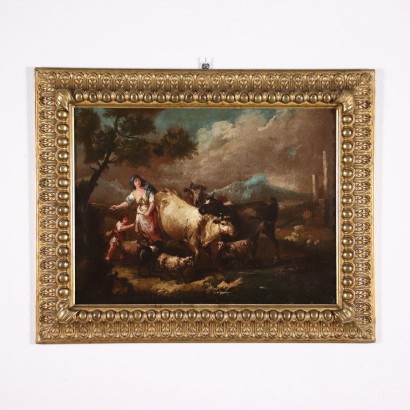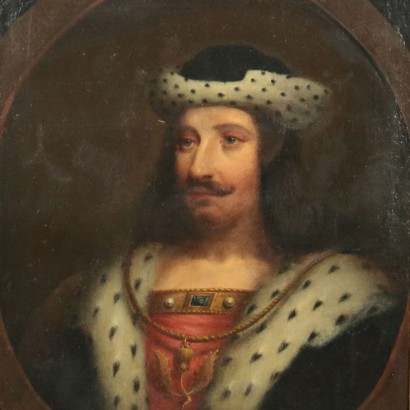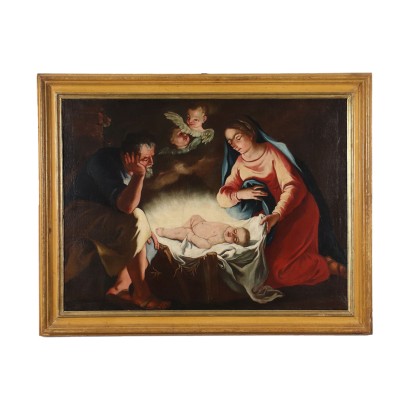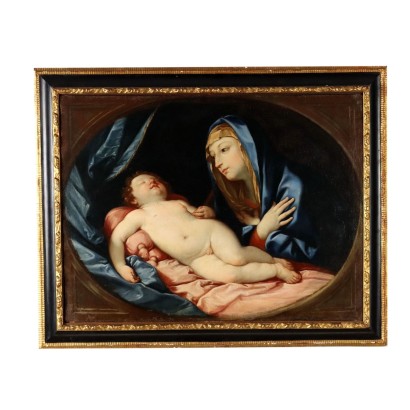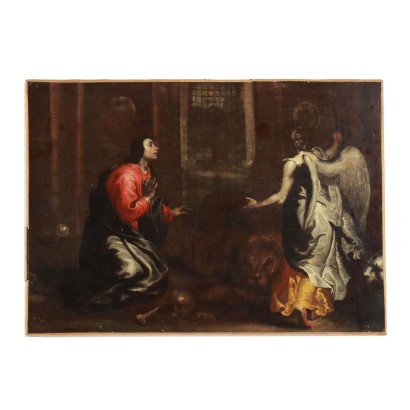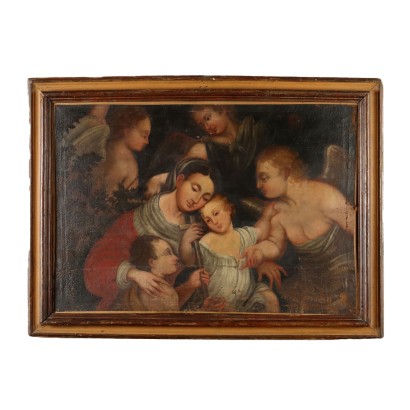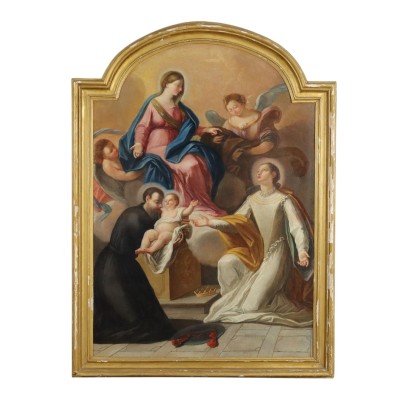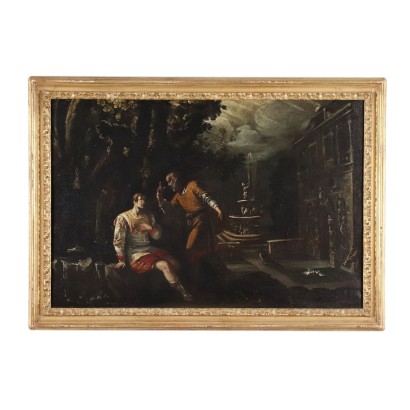Oil on Canvas by Giuseppe Zais Italy XVIII Century - River Landscape with Shepherdess Child and Herds
Features
River Landscape with Shepherdess Child and Herds
Artist: Giuseppe Zais (1709-1781)
Artwork title: Paesaggio fluviale con pastorella, fanciullo e armenti
Age: 18th Century / 1701 - 1800
Subject: Landscape with Figures
Origin: Italy
Artistic technique: Painting
Technical specification: Oil on Canvas
Description : Paesaggio fluviale con pastorella, fanciullo e armenti
Oil on canvas. The painting is accompanied by the expertise of two art historians, dr. Dario Succi and Dr. Federica Spadotto. Both confirm the attribution of the painting to Giuseppe Zais, "the master from Belluno unanimously recognized as one of the most original and genuine interpreters of the great landscape painting of the Venetian seventeenth century." In the landscape, under the branches of a tree that frames the left and with the background of blue mountains, a shepherdess and her little son stand out in the foreground, making their animals (sheep and cows) water from the river. the Zais, after an initial training in his native country at the school of his fellow countryman Marco Ricci, who moved to Venice in 1732, soon became part of the ranks of lagoon landscape architects, appreciated and hired for large decorative works in the palaces of the city. In the 1970s the Zais abandoned this production and chose to devote himself only to small works, which reflected an adhesion to the world of the humble and a contemplative dimension of the past, rarely subjects present in the paintings of important clients. The work presented here can be considered an example of this last creative phase, according to art historians in the 70s of the eighteenth century: the Zais proposes a rather barren foothill landscape, where the shepherdess followed by her little son play the their assignment, without any concession to an ideal beauty, but rather with a reminder of a precise, hard, simple real life, made up of effort and affection at the same time. Even the colors of the canvas enhance the artist's empathy for the world he depicts: the warm golden-brown tones of the landscape, illuminated by the blue of the distant peaks reverberating that of the sky, envelop the human and animal figures in the foreground, which they emerge thanks to material brushstrokes and brighter but not bright colors, especially in the fleece of animals and in women's clothes. Peculiar of the Zais are also the faces, round and full, with features that are repeated always identical in the peasant figures of his works, associated with turned bodies, dressed in clothes that look like papier-mâché. The work shows signs of restoration, although still on the first canvas. On the back there is an inscription in German with the name of the previous owner and the date "Christmas 1977". It is presented in a gilded frame from the early 1900s, with small cracks and lacks.
Product Condition:
Painting in good conditions, with small signs of age.
Frame Size (cm):
Height: 75
Width: 92
Depth: 5
Artwork dimensions (cm):
Height: 55
Width: 72,5
Additional Information
Artist: Giuseppe Zais (1709-1781)
Age: 18th Century / 1701 - 1800
18th Century / 1701 - 1800Subject: Landscape with Figures
Artistic technique: Painting
La pittura è l'arte che consiste nell'applicare dei pigmenti a un supporto come la carta, la tela, la seta, la ceramica, il legno, il vetro o un muro. Essendo i pigmenti essenzialmente solidi, è necessario utilizzare un legante, che li porti a uno stadio liquido, più fluido o più denso, e un collante, che permetta l'adesione duratura al supporto. Chi dipinge è detto pittore o pittrice. Il risultato è un'immagine che, a seconda delle intenzioni dell'autore, esprime la sua percezione del mondo o una libera associazione di forme o un qualsiasi altro significato, a seconda della sua creatività, del suo gusto estetico e di quello della società di cui fa parte.Technical specification: Oil on Canvas
The oil painting is a painting technique using powder pigments mixed with bases in inert and oils.Other customers have searched:
Pittura antica, artisti italiani, pittura olio su tela, arte 800, pittura antica, arte novecento, oggetti d'arte, ritratto di signora, dipinto animali, quadro paesaggio montano, dipinto olio su tela, dipinto antico, dipinti natura morta, quadro antico, quadro del '600, pittori italiani quadri olio su tela paesaggi, paesaggio marino dipinto, paesaggio invernale dipinto, paesaggio autunnale dipinto, dipinto di paesaggio, arte antica, quadro religioso..
Se sei un appassionato d'arte, non perderti i nostri approfondimenti sul Blog Arte Di Mano in Mano e su FineArt by Di Mano in Mano - Arte:
Leggi di più
Ecco alcuni tra i principali articoli:
Vedute
Falsi nell'arte antica
Un messaggio di fiducia per ripartire
La potenza espressiva dell'arte figurativa etiope
Breve Storia del Collezionismo
Giorgio Upiglio, maestro dei libri d'artista
Matthias Withoos detto "Calzetta bianca"
San Rocco pensaci tu - Classic Monday
Dai un'occhiata alle nostre rubriche di divulgazione sull'arte:
Epoche
Lavorazioni e tecniche
Mostre ed Eventi
Protagonisti
Se sei appassionato di pittura antica, con tutta probabilità gusterai le schede di questi stupendi quadri:
"Dio parla a Noè dopo il diluvio", Jacopo da Ponte, detto il Bassano, seconda metà XVI secolo
Crocifissione, maestro della misericordia dell'accademia, terzo quarto del XIV secolo
Erminia incontra i pastori, Camillo Gavassetti, Seconda metà anni Venti del XVII Secolo
Eroine dell'antichità, Francesco Conti, XVIII secolo
Hieronymus III Francken, La Negazione di Pietro, XVII secolo
Jefte e la figlia, Girolamo Forabosco e aiuti, XVII secolo
L'Accademia di Platone, piccolo arazzo, fine XVII - inizio XVIII secolo
Maddalena e San Giovanni Battista
Natura Morta, Bartolomeo Arbotori, XVIII secolo
Sacra Famiglia con San Giovannino, Bartolomeo Ramenghi, scuola di, prima metà XVI secolo
Testa Femminile, Andrea del Sarto, ambito di, post 1522
Uva, fichi, melagrana e pesche su un capitello - Maximilian Pfeiler, primo quarto XVIII secolo
Sapevi che l'arte può essere anche un ottimo investimento (e non solo per grandi portafogli)?
L'Arte tra Collezionismo e Investimento
FineArt: Arte come investimento
Leggi di più
Ecco alcuni tra i principali articoli:Vedute
Falsi nell'arte antica
Un messaggio di fiducia per ripartire
La potenza espressiva dell'arte figurativa etiope
Breve Storia del Collezionismo
Giorgio Upiglio, maestro dei libri d'artista
Matthias Withoos detto "Calzetta bianca"
San Rocco pensaci tu - Classic Monday
Dai un'occhiata alle nostre rubriche di divulgazione sull'arte:
Epoche
Lavorazioni e tecniche
Mostre ed Eventi
Protagonisti
Se sei appassionato di pittura antica, con tutta probabilità gusterai le schede di questi stupendi quadri:
"Dio parla a Noè dopo il diluvio", Jacopo da Ponte, detto il Bassano, seconda metà XVI secolo
Crocifissione, maestro della misericordia dell'accademia, terzo quarto del XIV secolo
Erminia incontra i pastori, Camillo Gavassetti, Seconda metà anni Venti del XVII Secolo
Eroine dell'antichità, Francesco Conti, XVIII secolo
Hieronymus III Francken, La Negazione di Pietro, XVII secolo
Jefte e la figlia, Girolamo Forabosco e aiuti, XVII secolo
L'Accademia di Platone, piccolo arazzo, fine XVII - inizio XVIII secolo
Maddalena e San Giovanni Battista
Natura Morta, Bartolomeo Arbotori, XVIII secolo
Sacra Famiglia con San Giovannino, Bartolomeo Ramenghi, scuola di, prima metà XVI secolo
Testa Femminile, Andrea del Sarto, ambito di, post 1522
Uva, fichi, melagrana e pesche su un capitello - Maximilian Pfeiler, primo quarto XVIII secolo
Sapevi che l'arte può essere anche un ottimo investimento (e non solo per grandi portafogli)?
L'Arte tra Collezionismo e Investimento
FineArt: Arte come investimento



